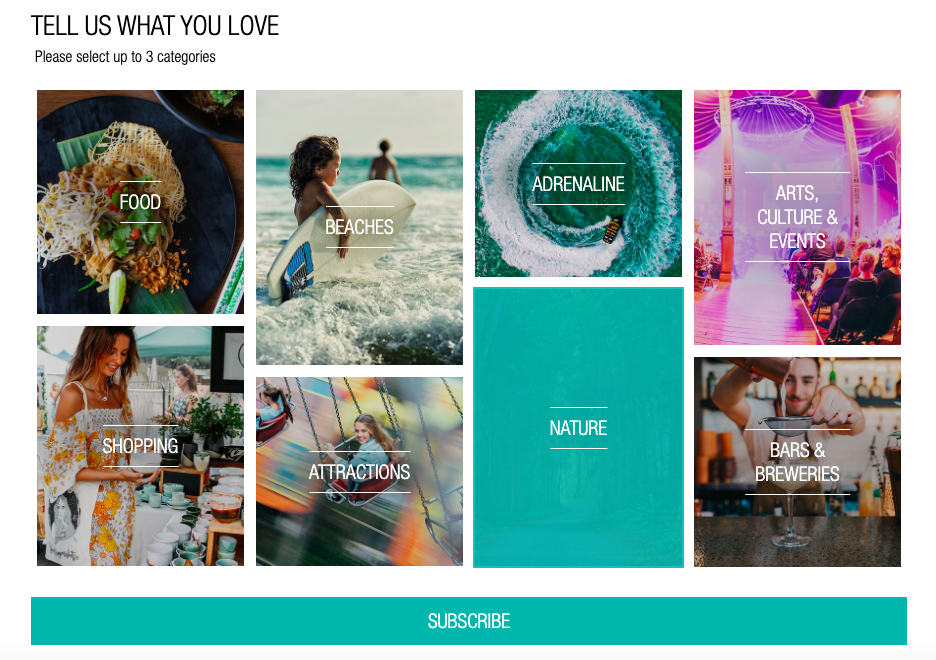
5 Statistics That Prove Preference Centres are Essential for Email Success
Everyone has their preferences. Some people prefer smooth peanut butter over crunchy. Some prefer red wine over white. And some even prefer dark chocolate over milk chocolate.
The world of email is no different. Every subscriber has their own unique preferences. Whether it’s send frequency, email content, or personalisation preferences, everyone is different. In an industry driven by data, capturing and understanding these individual preferences can be the difference between growing your email list, or watching the unsubscribes roll in. That’s where email preference centres come in.
These days, email preference centres are a key component of any well-planned email marketing strategy. At their core, email preference centres are exactly what they sound like – a user-friendly way for your email subscribers to share their preferences.
A well-designed email preference centre puts subscribers in control of their inbox, offering a simple choice: receive more emails they love, and fewer emails they’re not interested in. By tailoring emails to your subscribers’ preferences, messages are more likely to feel relevant, personalised, and better meet your subscribers’ needs.
According to SendGrid, “an email preference centre is so powerful because it gives your subscribers an option other than removing themselves completely from your marketing list. Keeping marketable leads in the mix is a win for your business and, more importantly, it’s an overall better experience for your subscribers”[1].
With this in mind, we’ve decided to take a closer look at the benefits of preference centres, offering five key reasons why preference centres are an email essential, plus a bonus example of an XCOM preference centre in action!
#1 Subscribers Want Choice
Let’s start with the big one first: 60% of users prefer to tell companies exactly what kinds of email they’re interested in receiving when they provide their email address for the first time.
That’s pretty compelling evidence that preference centres are non-negotiable for most potential subscribers.
That’s right, people want preference centres. And why wouldn’t they? It’s a win-win for everyone. Subscribers receive emails that are more relevant to their interests, and you get a more engaged, attentive email list.
Despite this, 60% of marketers don’t give subscribers the option to select the kinds of emails they want to receive, while a further 70% of marketers don’t allow subscribers to select how often they want to be emailed[2].
Ultimately, this can lead to disengaged subscribers, or, worse, an increase in unsubscribes. Speaking of which…
#2. Why Users Unsubscribe
People are lazy. You know it. I know it. We use abbreviations, shortcuts, and other time-savers whenever possible. It’s just a fact of life.
So, it should come as little surprise that 43% of users will mark an email as spam because they either find it difficult to unsubscribe, or simply can’t be bothered.
When your emails don’t meet your subscribers’ needs, their knee-jerk reaction is often to unsubscribe. But what if they just want to receive fewer emails, or only want to receive messages about a specific product? You don’t want to lose these subscribers by sending emails that don’t meet their preferences.
According to Campaign Monitor, 60% of users unsubscribe from an email list because the organisation sends too frequently. Similarly, 13% unsubscribe because their circumstances have changed, while 8% unsubscribe because they have found a competitor organisation that provides more relevant information[2].
A similar study by MarketingSherpa produced the top five reasons users unsubscribe from email lists. According to the survey of 2,400 people, users unsubscribe due to ‘too many emails in general’ (26%), ‘emails that are not relevant’ (21%), ‘too many emails from a specific company’ (19%), ‘emails that are too sales oriented’ (19%), and ‘uninteresting content’ (17%)[3].
Evidently, email frequency and irrelevant content are two of the most common reasons users unsubscribe from an email list. In all likelihood, you’ve unsubscribed from an email list for these exact reasons.
While this is fine in isolation, if you are aware of your subscribers’ send frequency and content preferences, you can adjust your email marketing accordingly to retain these subscribers.
According to SendGrid, since implementing a preference centre rather than a single option unsubscribe, they have noticed a “20% drop in total unsubscribes” from their email program[1]. There you have it, preference centres really work.
#3. Segmentation Success
At their core, preference centres are an exercise in more precise email segmentation.
It’s all well and good to take an educated guess and divide customers into segments based on demographics, previous behaviour, or location, but few things are more valuable than customers actively telling you what segments they want to be placed in.
Only interested in receiving emails once a month about new product offers? Perfect! Essentially, preference centres can take the guesswork out of segmentation.
Most of us are probably already familiar with the benefits of segmentation, but in case you need a quick refresher, we’ve got you covered. According to a comprehensive analysis, segmented email campaigns drive 760% more revenue than ‘one size fits all’ campaigns[4].
Additionally, email open rates are 14.3% higher for segmented campaigns than non-segmented campaigns, while segmented email campaigns achieve 100.95% higher click-through rates than non-segmented campaigns[5].
With these benefits in mind, asking users to self-segment via preference centres seems like a no-brainer!
#4. Every Subscriber is Different
As we know, every user is different. Through marketing automation technologies and advanced analytics, you can occasionally predict some user behaviours with relative accuracy, but at the end of the day, people are unpredictable. How unpredictable are they? Let’s examine the following email statistic.
According to MarketingSherpa, 61% of users prefer to receive marketing promotional emails once a month. However, 15% of users say they like receiving marketing promotional emails daily. At face value, this statistic seems contradictory. Ostensibly, the two cannot co-exist within a single email marketing strategy.
Without preference centres and segmentation strategies, you would have to choose between appeasing the 61% who want monthly promotional emails, while possibly alienating the 15% who prefer daily promotional emails.
Obviously, with a well-designed email preference centre, this problem can be solved by devising content that suits both groups.
Further, without a preference centre, it would be nearly impossible to accurately predict different users’ frequency preferences. Inevitably, you would have to alienate some of your subscribers by either sending too frequently, or not frequently enough.
Preference centres eliminate this dilemma, by allowing you to predict the unpredictable.
#5. Hygiene Helper
Email list hygiene. It may not be the flashiest or most exciting combination of words, but in the world of email marketing, it is a must.
On average, email lists depreciate by 25% each year. Think about that, a quarter of your subscribers lost, simply due to poor list hygiene.
Likewise, Campaign Monitor found that between 15-25% of all valid email addresses are discarded each year. Common reasons for this include people moving to a different ISP, changing jobs, or otherwise acquiring a new email address[4].
This is a major problem, with a relatively simple solution: allow subscribers to update their details – particularly their email address – within a preference centre.
Doing so will allow you to maintain better email list hygiene, keep your subscribers’ details up to date, ensure you don’t lose subscribers unnecessarily, and, most importantly, ensure your subscribers keep receiving your awesome content! It’s a win-win-win.
Preference Centres in Action

This all sounds great in theory, but if you want to see a best-in-class example of preference centres in action, look no further than our friends at Destination Gold Coast.
As pictured above, their eye-catching ‘Tell Us What You Love’ design provides a simple and engaging way for customers to self-segment, while selecting their personalised content preferences.
References
[1]https://sendgrid.com/blog/the-power-of-an-email-preference-center/
[3]https://www.wiredplus.com/hub/email-marketing-preference-centres-why-important/
[4]https://www.campaignmonitor.com/resources/guides/email-marketing-new-rules/
[5]https://backlinko.com/email-marketing-stats#email-segmentation-and-personalization-stats
Image by: Gerd Altmann from Pixabay